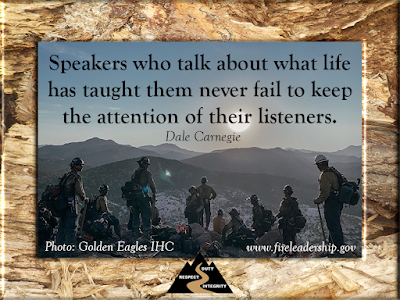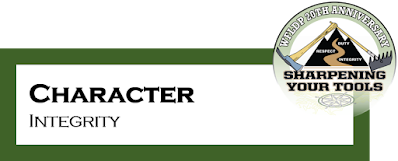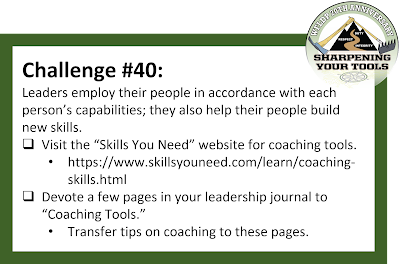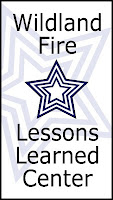A forum where students of fire and leadership come together to discuss, debate and exchange leadership development concepts, experience, and thoughts with an intent to promote cultural change in the workforce and strengthen the wildland fire service and the communities they serve.
Pages
Thursday, September 30, 2021
IGNITE - The Language of Leadership
The art of communication is the language of leadership. – James Humes, former presidential speechwriter
[Photo: Austin Catlin/BLM]
Wednesday, September 29, 2021
Integrity - Summary
- Know yourself and seek improvement.
- Seek responsibility and accept responsibility for your actions.
- Set the example.
Tuesday, September 28, 2021
Leaders Are Readers and Writers
Today's blog is inspired by Jacqueline Woodson's TedTalk "What Reading Slowly Taught Me About Writing." Jacqueline talks about how the speed reading craze impacted her ability to write. Like Jacqueline, I was a child of the '70s and remember how much this effort affected reading in my family.
Monday, September 27, 2021
IGNITING: The Right Word
The difference between the right word and the almost right word is the difference between lightning and the lightning bug. - Mark Twain
[Photo: Garrett Loper]
Saturday, September 25, 2021
Moral Courage - Stories from the Fireline
The horrifying tangle of bodies and fire shelters on the side of Storm King Mountain after the afternoon blowup spoke of chaos and desperation—an attempted escape gone terribly wrong.
Friday, September 24, 2021
Challenge #38 - 2021 WFLDP Campaign
Challenge #38: Good leaders intentionally work on being good communicators.
- In your journal, construct a plan to develop your oral communication skills.
- Volunteer to conduct a briefing/debriefing. Consider being filmed.
- Ask for constructive feedback from a coach and your peers.
- Join a professional public speaking group, such as Toastmasters.
• Practice, practice, practice!
Thursday, September 23, 2021
IGNITE: Bad Once
Wednesday, September 22, 2021
Moral Courage
Wildland fire leaders demonstrate moral courage by adhering to high ethical standards and choosing the difficult right over the easy wrong. We avoid ethical dilemmas by directing team members to operate in ways that are consistent with our professional standards and by directing them only to actions they can achieve ethically.
Tuesday, September 21, 2021
Speak Up
Monday, September 20, 2021
IGNITE: Talking About Life
Saturday, September 18, 2021
Character
Character is based on values. It is the combination of actions and words that others appraise to determine if we can be trusted to do the right thing. Character is the most valuable asset we have as leaders because it, more than anything else, promotes or hinders the development of trust.
Friday, September 17, 2021
Challenge #37 - 2021 WFLDP Campaign

- Develop a plan to enhance your team’s active listening skills.
- Review "Active Listening Exercises: 10 Team Activities to Improve Active Listening" by The 10-Minute Leader.
Thursday, September 16, 2021
IGNITE: Listening As An Art
Wednesday, September 15, 2021
Setting the Example
Fire leaders set the example by exhibiting strong character, by showing optimism and encouraging others, even when facing setbacks.
[Click here to download a copy of Leading in the Wildland Fire Service.]
Tuesday, September 14, 2021
Tools for Communication
Monday, September 13, 2021
One Year Later - A Story of Resilience
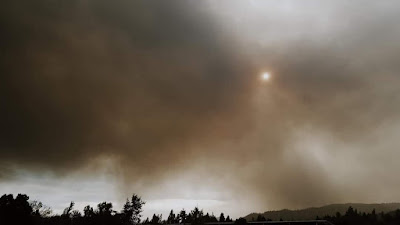 |
| Almeda fire 2020, Josh and Josie Woodbridge |
by Josie Woodbridge
[Our most powerful stories come from the field. With permission we share Josie Woodbridge's story. Josie and Josh, a former Asheville hotshot now working for Rogue River-Siskiyou National Forest, lost their home in Talent, OR, to the Almeda fire.]
IGNITE: More Than Hearing
[Photo: TJ O'Neill/Prescott IHC]
Sunday, September 12, 2021
Staff Rides We Need Your Help Please (Maybe you need ours...)
 |
| Blue Ribbon Staff Ride, Florida Forest Service |
Have you heard of a local staff ride? Been to one? In my experience, it seems the term staff ride is tied to places or events we have all heard of. Fact is many staff rides have been built for local events many of us may not be familiar with. I say event, because again, they all differ and can be about almost anything.
During this year’s campaign we sharpened the staff ride portion of the toolbox. Staff rides came up during the week of remembrance, and yet again as we discussed experiential learning. Basically, staff rides are intertwined and ingrained in our culture, and for good reason. Therefore, we come to you with a request and an offer—a from-the-field-for-the-field staff ride development collaboration.
Saturday, September 11, 2021
Reflecting on 9/11
 |
| (Photo credit: Depot Section Supervisor Robbie Swofford, Remote Sensing/Fire Weather Support) |
IMT Lessons Learned and Shared from 9/11
(Scratchline, Issue 1, Summer 2002)
This incident was unlike any previous Incident Management Team (IMT) assignment. The sheer scope of the incident, its cause, the number of human lives impacted, destruction, financial impact incurred, limited geographic area (1/4 square mile), multiple agency involvement, and international significance are unprecedented in IMT history.
Van Bateman's Southwest Area Type 1 IMT was mobilized to assist the Federal Emergency Management Agency (FEMA) within hours of the terrorist attack. This team worked at the FEMA Incident Command Post (ICP) in Lower Manhattan and at the New York City Fire Department ICP for approximately one month. Joe Stutler's Pacific Northwest Area Type 1 IMT, Mike Lohrey's
Pacific Northwest Area Type 1 IMT, and Joe Stam’s Alaska Area Type 1 IMT were dispatched to support responding agencies and their personnel working at Ground Zero.
Captured below are some of the IMTs’ lessons learned during this catastrophic event:
Planning
Each Section Chief and Unit Leader needs to pay extremely close attention to their personnel for signs of stress. A means of debriefing needs to be set up, both at the incident site and at the home unit, for those adversely affected. Some of these needs were identified late and personnel were already demobilized and back at their home unit before arrangements were made for critical
incident stress management services.
Logistics
IMT's should be aware that picture identifications are a necessity. Security was very tight and security protocols constantly changing. Access into many areas was denied without proper I.D.
IMT's should expect to spend extra time to ensure compliance with existing national standards when using shower or catering units that are not on the National Contract.
In large urban areas, there can be over 100 VHF and UHF radio systems in use. Dozens of systems were brought in and used on an emergency basis. A comprehensive communication plan was lacking. A meeting to facilitate the coordination of all emergency services communication staffs needs to be scheduled early on to develop a communication plan and to reduce duplication of resources.
Operations
IMT's need additional training in FEMA operational structure including its mission, organization, and ordering procedures. This should be incorporated into team meeting agendas as well as in formal
training.
Type 1 crews were ordered to assist in the warehouse operation and with camp duties. This should be standard procedure for this type incident. Traditional camp crews are not viable due to the location, political environment, and work required.
Finance
Finance Section Chiefs must receive clear directions on specific procedures required by FEMA. They should immediately coordinate actions with FEMA comptrollers and procurement officials. The U.S. Forest Service National Incident Business Advisor should be contacted for assistance.
Information
The process to obtain permission for in person interviews was lengthy and often required more time than the media representatives could afford. Several interview requests were cancelled because interview deadlines could not be met. Phone interviews replaced live interviews when live ones could not be conducted in a timely manner. Expect that rigid protocol and multi-layered permission processes will prevent full and effective utilization of normal IMT information resources.
Safety
Not all people are suited for a disaster assignment. Because of the emotional impact of the situation, IMT's and Geographical Area Coordination Center's (GACC) should expect a certain percentage of personnel to request incident reassignment or demobilization almost immediately after arrival. This should not necessarily be seen as a performance problem. The reality of the situation has a greater
impact on some than they might have anticipated.
Summary
Patience is a must. What might be considered small tasks or slow movements by many IMT members can be huge strides for other agencies in time of crisis – especially when they have a long tradition of self-reliance and have been directly affected by a loss of personnel, equipment, and facilities.
**********************
Scratchline, Issue 1, Summer 2002
FDNY's Commitment to Everyone Goes Home
Things to Ponder:
- Do you have dedicated programs for health and wellness, training, and safety?
- What are you doing to innovate and improve fireground operations with technological advancements?
- What training initiatiaves have you implemented to ensure that "Everyone Goes Home"?
- Have you established a health and wellness program?
- Are you constanstly trying to improve?
- Do you view training as a managerial or personal concern?
 |
| (FDNY at the Gettysburg Staff Ride. Photo credit: OMNA International LLC) |
Accountability
Leaders are responsible for the decisions they make and for the actions they take. This responsibility also means that fire leaders are accountable for their teams—for the decisions they make and the actions they take based on the leader’s intent provided to them.
Friday, September 10, 2021
Challenge #36 - 2021 WFLDP Campaign
Challenge #36: Good leaders hone their critical thinking skills.
- Read Albert Rutherford’s book "How to Think Critically."
- Watch “The Man Who Saved the World.”
- Discuss with your team how critical thinking and courage can bring to chaos.
Thursday, September 9, 2021
IGNITE: The Two Types of Decisions
There are two types of decisions: good decisions and lessons learned. - Simon Sinek -
[Photo: Anonymous]
Wednesday, September 8, 2021
Fitness for Command
Our position as leaders requires us to take people into unpredictable situations where mediocre leaders can be quickly overwhelmed in a crisis and make dangerous errors in judgment.
Tuesday, September 7, 2021
Challenge #40 - 2021 WFLDP Campaign
Challenge #40: Leaders employ their people in accordance with each person’s capabilities; they also help their people build new skills.
- Visit the “Skills You Need” website for coaching tools.
- Devote a few pages in your leadership journal to “Coaching Tools.”
- Transfer tips on coaching to these pages.
Making Sound and Timely Decisions

Making Sound and Timely Decisions
Leaders can optimize their decision space by using time efficiently. Seeking advance information in new situations or utilizing standard operating procedures for routine tasks are examples of techniques that make good use of available time.
In the wildland fire environment, decisions have serious consequences and often can have life-or-death implications for others. With so much on the line, we have a responsibility to understand the decision-making process—the components, the flow, the effect of time—and to develop the skills and confidence that enables us to make the best decision possible with the information and time available.
Decision-Making Skills for Fire Managers from David Garvin
Prescribed fire and fire use managers had the privilege of hearing from decision-making expert David Garvin, Harvard Business School professor and author of Learning in Action (recommended read in our Professional Reading Program). Share this video with your fire team today!

______________________________
Thanks to the Wildland Fire Lessons Learned Center for sharing this presentation with all of us.
This blog originally posted December 7, 2012.
Monday, September 6, 2021
IGNITE: Good and Bad Decisions
[Photo: Kootenai National Forest/USFS]
Saturday, September 4, 2021
Seeking and Accepting Responsibility for Our Actions
Fire leaders seek responsibility and accept responsibility for their actions. We also accept full responsibility for poor team performance, credit subordinates for good performance, and keep superiors informed.
[Click here to download a copy of Leading in the Wildland Fire Service.]
Friday, September 3, 2021
Challenge #35: 2021 WFLDP Campaign
- Assess how committed your organization is to resilience by taking Dr. Karl Weick and Dr. Kathleen Sutcliffe’s survey → https://www.mro.net/MRODocuments/MRO%20HERO%20Survey.pdf
- Read Managing the Unexpected: Assuring High Performance in an Age of Complexity by Dr. Karl Weick and Dr. Kathleen Sutcliffe.
Thursday, September 2, 2021
IGNITE: The Ultimate Team Result - Resilience
| (Photo Credit Josh Neighbors/South Dakota Wildland Fire) |
Wednesday, September 1, 2021
Increasing What is Known
Fire leaders seek and accept feedback to maintain accurate situation awareness about ourselves. We are willing to examine and probe blind spots, seeking feedback from others. Because blind spots can lead to problems, leaders accept and act on feedback as part of the responsibility to mitigate error.








